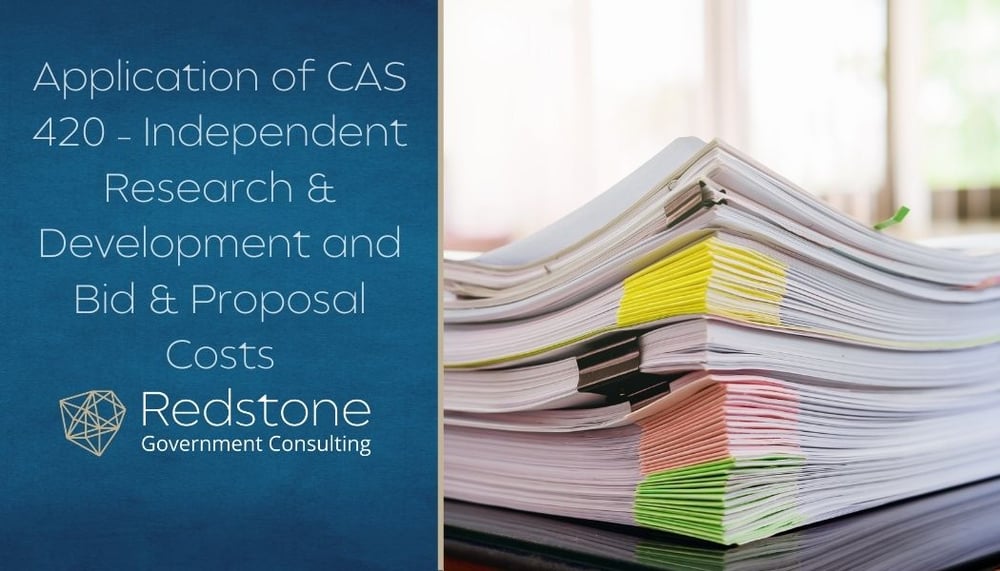
Accounting for independent research and development costs and bid and proposal costs are found in Far 31.205-18 and Cost Accounting Standards 420. Because FAR 31.205-18 incorporates CAS 420, it does not matter if your company has revenue of $50 million or under $5 million; if you have IR&D and B&P costs, this Cost Accounting Standard (CAS) provides the criteria for accumulation and allocation of those costs.
Definitions:
- “Bid and proposal (B&P) costs” means the costs incurred in preparing, submitting, and supporting bids and proposals (whether or not solicited) on potential Government or non-Government contracts. The term does not include the costs of effort sponsored by a grant or cooperative agreement, or required in the performance of a contract.
- “Independent research and development (IR&D)” means a contractor’s IR&D cost that consists of projects falling within the four following areas: (1) basic research, (2) applied research, (3) development, and (4) systems and other concept formulation studies. The term does not include the costs of effort sponsored by a grant or required in the performance of a contract. IR&D effort shall not include technical effort expended in developing and preparing technical data specifically to support submitting a bid or proposal.
Requirements
When accumulating and allocating IR&D and B&P costs, the following are the requirements provided by CAS.
- CAS 9904.420-40(b) – “The IR&D and B&P project costs shall consist of all allocable costs, except business unit general and administrative expenses.”
- CAS 9904.420-50(a) – “The IR&D and B&P project costs shall include (1) costs, which if incurred in like circumstances for a final cost objective, would be treated as direct costs of that final cost objective, and (2) the overhead costs of productive activities and other indirect costs related to the project based on the contractor’s cost accounting practice or applicable Cost Accounting Standards for allocation of indirect costs.”
This means IR&D and B&P project costs are almost the same as a final cost objective and captured similar to a contract. Costs directly associated with the IR&D and B&P project such as labor, travel, other direct costs, and subcontracts should be accumulated as an IR&D or B&P project. These direct costs are burdened with overhead; however, no general and administrative (G&A) expenses are applied to the project (hence, almost the same as a final cost objective). Direct costs and indirect costs, if incurred in like circumstances, should be treated consistently. Costs that can be directly identified with an IR&D and B&P project may need to be further analyzed to determine the proper method for identifying and allocating IR&D and B&P costs, such as labor. For example, an employee that typically charges G&A all year but helps with the administrative role of the IR&D and B&P effort, even though this employee’s time is directly associated with the IR&D and B&P project, would not be considered direct labor. If an administrative person’s functions are ordinarily charged as G&A, rather than direct, then costs for these same duties, when incurred in conjunction with an IR&D or B&P effort, would not be charged direct to an IR&D and B&P project, and would instead be charged to G&A. It is the same for an employee who typically charges time to Overhead. Labor costs ordinarily identified as direct to a project would be treated the same as direct for IR&D and B&P projects when those charges benefit an IR&D and B&P project. Another example: if the contractor’s policy states that travel costs directly identified to a contract should be charged direct, whether billable or non-billable, then any travel for IR&D and B&P effort that can be directly identified to that project should be accumulated consistently with costs incurred in like circumstances. Thus, travel directly identified to the IR&D or B&P effort should be considered direct travel for that project.
In addition, CAS 420 requires IR&D and B&P project costs to allocate overhead costs to the final cost objective. These costs are allocated based on the beneficial or causal relationship between such costs and cost objectives. Therefore, the allocation base for the overhead pool must include the IR&D and B&P labor.
Example
Contractor overhead has an allocation base of direct labor dollars. The following are costs incurred for the fiscal year:
| Direct Labor | FY Dollars |
| Contract A | $200,000 |
| Contract B | $300,000 |
| Contract C | $ 50,000 |
| Subtotal | $550,000 |
| B&P Projects | $ 10,000 |
| IR&D Projects | $ 50,000 |
| Total | $610,000 |
The allocation base for the overhead pool must include the IR&D and B&P labor in accordance with CAS 420; thus the $610,000 would be the overhead base amount.
All IR&D and B&P costs are allocated using the same base as for allocating business unit G&A expenses. Technically, IR&D/B&P are not G&A, but many contractors include these cost in the overall G&A pool and the G&A rate. Because contractors treat IR&D/B&P the same as G&A expenses, IR&D/B&P expenses are effectively in the G&A pool and excluded from the G&A base.


 Kimberly is a Managing Consultant with Redstone Government Consulting, Inc. based in our Huntsville, Alabama office. Her areas of expertise include working with government contract accounting and contracting issues and audit. Kimberly specializes in assisting government contractors in the unique accounting, pricing, proposal preparation, and compliance requirements of the U.S. Government. Professional Experience Kimberly’s experience includes preparation of complex incurred cost submissions, compliant accounting infrastructure, preparation and evaluation of policies and procedures, contract closeout process, developing provisional indirect rate budgets, monitoring actual indirect rates, and providing audit support to government contractors. Her primary focus is working pro-actively in preparing small contractors for government contract challenges as well as resolving DCAA issues. Kimberly has almost ten years of experience assisting clients with Federal Acquisition Regulations (FAR) and Cost Accounting Standards (CAS) best practices and compliance. She works with government contractors to comply with critical Federal Acquisition Regulations (FAR) requirements related to cost accounting and proposals. Her sundry experience with various government contract issues and successful resolutions provides insight that benefits our clients. Prior to joining Redstone Government Consulting, Inc., Kimberly specialized in assurance and advisory services with a regional firm (Jackson Thornton), working as a staff accountant conducting compilations and reviews, auditing financial statements and assisting with litigations. Education Kimberly earned a Bachelor of Science degree in Commerce and Business Administration from The University of Alabama in 2007. Affiliations National Contract Management Association Women in Defense
Kimberly is a Managing Consultant with Redstone Government Consulting, Inc. based in our Huntsville, Alabama office. Her areas of expertise include working with government contract accounting and contracting issues and audit. Kimberly specializes in assisting government contractors in the unique accounting, pricing, proposal preparation, and compliance requirements of the U.S. Government. Professional Experience Kimberly’s experience includes preparation of complex incurred cost submissions, compliant accounting infrastructure, preparation and evaluation of policies and procedures, contract closeout process, developing provisional indirect rate budgets, monitoring actual indirect rates, and providing audit support to government contractors. Her primary focus is working pro-actively in preparing small contractors for government contract challenges as well as resolving DCAA issues. Kimberly has almost ten years of experience assisting clients with Federal Acquisition Regulations (FAR) and Cost Accounting Standards (CAS) best practices and compliance. She works with government contractors to comply with critical Federal Acquisition Regulations (FAR) requirements related to cost accounting and proposals. Her sundry experience with various government contract issues and successful resolutions provides insight that benefits our clients. Prior to joining Redstone Government Consulting, Inc., Kimberly specialized in assurance and advisory services with a regional firm (Jackson Thornton), working as a staff accountant conducting compilations and reviews, auditing financial statements and assisting with litigations. Education Kimberly earned a Bachelor of Science degree in Commerce and Business Administration from The University of Alabama in 2007. Affiliations National Contract Management Association Women in Defense